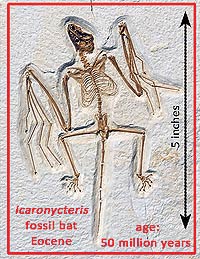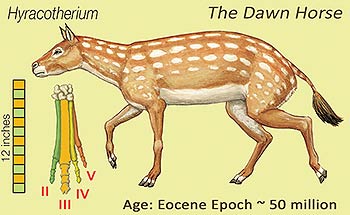 |
| Icaronycteris was the first true bat, and a true pioneer of mammal flight. |
Similar Causes (an excerpt)
by Charlotte Perkins Gilman
There was once a little animal,
No bigger than a fox,
And on five toes he scampered
Over Tertiary* rocks.
They called him Eohippus,
And they called him very small,
And they thought him of no value --
When they thought of him at all;
For the lumpish old Dinoceras**
And Coryphodon**
so slow
Were the heavy aristocracy
In days of long ago.
Said the little Eohippus,
“I am going to be a horse!
And on my middle finger-nails
I’ll run my earthly course!
I’m going to have a flowing tail!
I’m going to have a mane!
I’m going to stand fourteen hands high
On the psychozoic plain!”
The Coryphodon** was horrified,
The Dinoceras** was shocked;
And they chased young Eohippus,
But he skipped away and mocked.
Then they laughed enormous laughter,
And they groaned enormous groans.
And they bade young Eohippus
Go view his father’s bones.
Said they, “You always were as small
And mean as now we see,
And that’s conclusive evidence
That you’re always going to be.
What! Be a great, tall, handsome beast,
With hoofs to gallop on?
Why! You’d have to change your nature! Said the Loxolophodon**.
They considered him disposed of,
And retired with gait serene;
That was the way they argued
In “the early Eocene”.
|
Charlotte Perkins Gilman (1860-1935) was an extraordinarily progressive, psychologically- interesting, talented and ‘ahead-of-her-time’ “modern” woman. Her clever paleo-poem pokes fun and old convention and celebrates progress. She died a year before Charlie Chaplin’s film Modern Times was released.
* Tertiary broadly means “Cenozoic”
** Large Cenozoic mammals
|
Paleontologists like timelines, stories with beginnings and endings. So, in this year’s Paleo Happenings we have journeyed through the ‘old life’ Paleozoic era, the ‘mid life’ Mesozoic Era, and now come to the ‘recent life’ Cenozoic Era: named by we mammals as “The Age of Mammals and Birds.” The “Cen” root appears in the word recent. All the Cenozoic epoch names, Paleocene, Eocene, Oligocene, Miocene, Pliocene, Pleistocene also contain the root. Early geologists astutely recognized that the number of modern species increased steadily from the beginning of the Paleocene 65 million years ago to “Modern Times” (incidentally the title of a classic Charlie Chaplin film from 1936).
Traditionally the early Paleocene (‘ancient dawn of the recent’) has been regarded as a time when the world was bleak and empty after the extinction of the dinosaurs, pterosaurs, most marine reptiles and ammonites. However, recent finds from Corral Bluffs, Colorado indicated a remarkable “biotic recovery” among mammals which doubled their body size every 100,000 years, (Science, 2019, DOI: 10.1126/science.aay2268). On geologic time scales this is rapid, ‘blink-of-the-eye” evolution. By the Eocene (‘dawn of the recent’), beginning 56 million years ago, mammals had evolved many completely new forms including bats and whales.
The bat Icaronycteris was named after Icarus from Greek Mythology, who flew too close to the sun, melting the wax on his homemade wings. The bat Icaronycteris probably flew at night like its modern descendants, and despite pioneering mammal flight, but still met a mortal end in the lake deposits known as the Green River Formation, found over large parts of northeastern Utah, northwestern Colorado and southwestern Wyoming. The latter deposits known as “fossil lake” yield the famous “split fish” layer producing thousands of fish, many found for sale in various rock shops. Conditions in these lakes were such that a great diversity of fish, amphibians (frogs), reptiles (lizards, snakes, turtles and crocodiles), birds and mammals were sometimes preserved perfectly in exquisite detail, with skin and feathers intact. Among the more famous Eocene mammals is the ancestral horse Hyracotherium, originally named Eohippus (“dawn horse”) which had three functional toes and was described as the size of a fox terrier. It eventually evolved into the modern, one-toed horse (see poem).
 |
| Eohippus, the dawn horse was an early ancestor of our much-loved modern species. |
Tracks of these dawn horses from Utah proved they trotted around the lakes, which have also produced thousands of bird tracks from Utah County sites between Price and Spanish Fork (Moab Happenings Nov. 2020). Hoofed mammals or “ungulates” have been classified into the odd-toed and even-toed varieties (technically ‘perissodactyls’ and ‘artiodactyls’ respectively).
The odd-toed varieties include the horse, tapir and rhino families. The even toed varieties are cloven hoofed types and include sheep, buffalo, pig, camel and deer families (Moab Happenings, Sept 2021) which became dominant later in the Cenozoic as the climate cooled and warmer and wetter woodlands gave way to cooler and drier prairies.
Most paleontology students learn that the evolution of the North American prairies is a classic story of long-term climate change, tracked, (no pun intended) by the skeletal remains and tracks of the hoofed mammals common among today’s livestock. They are the loved species of “modern times” we serenade in their “home on the range where the deer and the antelope play.”
|